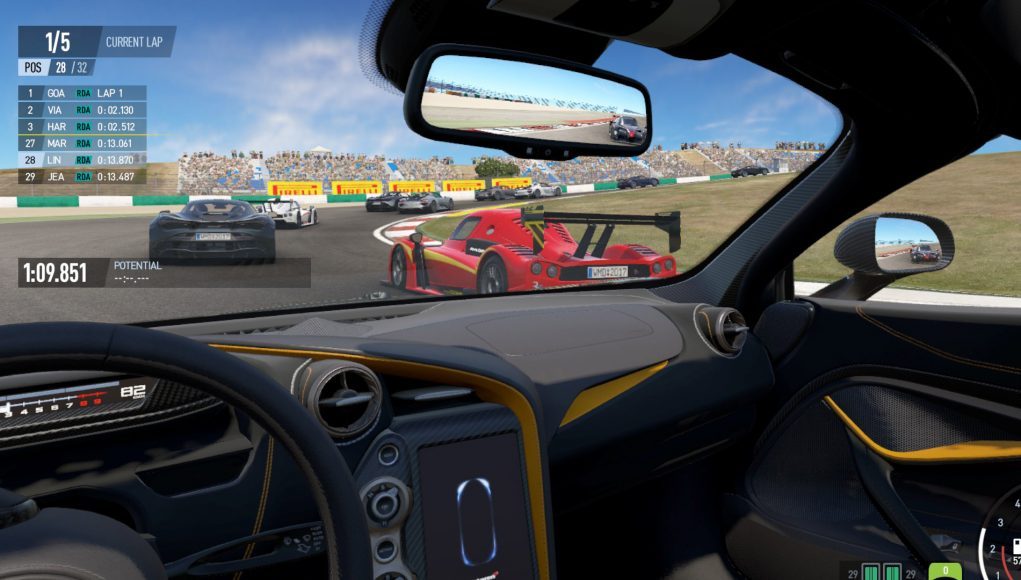Slightly Mad Studios, the minds behind the Project CARS franchise, announced that they’re getting into the hardware game with a brand new gaming console. Information is still thin on the ground surrounding the newly christened ‘Mad Box’, although company CEO Ian Bell has confirmed it will support VR headsets and 4K monitor output.
Update (January 4th, 2019): Slightly Mad Studios is now stating that Mad Box is dropping the 60 fps spec for VR headsets, and adopting 90 fps moving forward. Check out our more expansive piece covering this change, and a few more new developments including concept images and upcoming features.
Original Article (January 3rd, 2019): Mad Box is still in its early phases, with Bell telling Variety that the Xbox/PlayStation-style console should ship “around three years time.”
“It will support most major VR headsets and those upcoming and the specs will be equivalent to a ‘very fast PC 2 years from now’,” Bell told Variety. “We’re in early talks with manufacturers of components so we can’t say much more right now other than we have the designs specced out in detail.”
There’s no pricing on the table yet, although Bell contends it should be “competitive with upcoming console prices.”
While crowdfunding isn’t off the table entirely, Bell maintains the studio has lined up “multiple investors already offering the required funding […] to see the product to completion, but it’s still early days and we’re looking at the best offers right now.”
So far, that’s all we can say for sure.
Confusion Around FPS (see update)
Billing it as “the most powerful console ever built,” Bell tweeted out late last night that Mad Box will support VR headsets with 60 fps rendering, 4K monitor rendering, and will arrive with a free game engine so developers can create for Mad Box, presumably the company’s own Madness Engine.
What is the Mad Box? It's the most powerful console ever built… It's literally 'Mad'… You want 4k, you want VR at 60FPS? You want a full engine for free to develop your games on it? You have it.
— Ian Bell SMS (@bell_sms) January 2, 2019
After some prodding by the VR community, Bell attempted to clear up some confusion surrounding the fact that 60 fps VR rendering really doesn’t cut it when talking about the “most powerful console.” After all, PSVR game developers already have a hard 60 fps base requirement to publish on the PlayStation Store; that’s effectively doubled in the console to 120 fps for smoother viewing in-headset. That said, some PSVR apps do actually display at a native 90 fps and even fewer at a native 120 fps when played using PS4 Pro.
What resulted was slightly more confusing, as Bell later tweeted that 60 fps is somehow a feature for a console with three years left to go before productization, based on the reasoning that it’s 60 fps “per eye.”
Per eye…
— Ian Bell SMS (@bell_sms) January 2, 2019
Variety attempted to clarify the “per eye” statement with Bell via email, receiving word that Mad Box will actually support 120 fps for VR headsets. Great news, right? The confusion however persists as Bell responds to Twitter user ‘Galiforniano’ by saying that “60 plus 60 is always 120 … No matter who says it.”
Nope, 60 plus 60 is always 120… No matter who says it.
— Ian Bell SMS (@bell_sms) January 3, 2019
We’ve reached out to Slightly Mad Studios to clarify that statement, and will update when we hear back. (see update above)
In the meantime, this is most likely the source of the “60 plus 60” figure: the industry at large measures frames per second globally when in reference to VR output, and not according to what the rendering pipeline needs to do to in order to make that happen. This is because VR headset users will only perceive 60 fps even if the hardware must effectively render twice the frames split across two displays to serve up a stereoscopic view—resulting in the possibly unorthodox 120 fps clarification from Bell.
Oculus Rift, HTC Vive, and Windows VR headsets feature panels clocked at 90Hz, something that VR-capable PCs of today can sometimes struggle to fill during more graphically demanding scenes. An overwhelming majority of PC VR developers build apps designed to either match or exceed that refresh rate in order to appear smooth and comfortable to the user; a game rendering at 60 fps (globally) is the bare minimum for a comfortable experience, although some users notice screen flicker at this rate.
This is provided of course the console in question doesn’t use some form of reprojection such as Valve’s Motion Smoothing or Oculus’ Asynchronous Spacewarp. Both techniques cut the framerate down to 45 fps when the system can’t match the headset’s native refresh rate, and bump it back to 90 fps with the addition of synthetically generated frames to keep things moving smoothly. A similar technique, or even a simple doubling of the frames could alleviate this, although it’s difficult to call that the result of “the most powerful console.”
If Slightly Mad can somehow bring a VR-ready gaming console to market pushing greater frame rates than 60 fps (synthetically or otherwise), replete with a strong list of top VR titles and a reasonable price tag in comparison to an equally specced gaming PC, it may be an attractive option for console gamers looking to explore the world of PC VR headsets—they feature higher resolutions and better room-scale tracking capabilities than the current gen PSVR to say the least.
We’re hoping to learn more in the coming months about the game studio’s first dive into the console hardware market. However you slice it though, it’s certain to be slightly mad.







